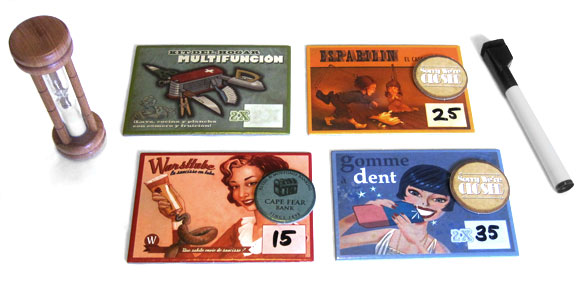
Panic on Wall Street
Overview
In Panic on Wall Street, players have a choice. They can play as Investors, investing in company stocks and hoping the market is kind to them. Or they can play as Managers, buying up companies and selling stock in these companies to the Inventors. Most of the action takes place in a real-time, 2-minute negotiation phase where stocks are bought low and hopefully sold for a profit. Managers sell stocks in their companies and hope to acquire as much value for them as possible. Deals are made and most certainly…tensions rise. After five turns the Manager and Investor with the most cash win.

Set Up
Players are first assigned roles in the game. Each player rolls a red die and those that roll the highest will play as Managers, the remaining players are the Investors. Players may choose their roles if they wish, but there must be an even number of each. (In cases of odd number of players, there is always one less Manager). Investors receive a stack of Bank investment tokens, (their player color) and a dry erase marker. The Company tiles are shuffled face down and three are dealt to each of the Managers. (Any 2X tiles are returned and re-dealt). All the players then receive $120,000 from the bank.
The Market board represents the value of each of four different shares, represented by colors that match the company tiles. (red, yellow, green and blue). Place the four market indicator chits on their corresponding shares’ “start” space. (Their starting value is $30k). The dice that also match those shares are placed to the side and will be rolled later. Managers flip their Company tiles and the game is ready to begin!
Gameplay
Panic on Wall Street gameplay is divided into five turns or months. Each turn is divided into five phases:
Negotiation Phase: The timer is flipped and Investors negotiate with Managers to purchase shares of their companies for the coming month, or turn. If a price is agreed upon, the Manager writes that number in the box on their Company tile. The Investor that made that bid places one of their Bank tokens on that Company tile to show they now have the highest bid. A Manager can agree not to take any more bids on that company if they wish, and flip that Investor’s Bank token to the “closed” side; locking in that bid for the remainder of the Negotiation phase. All this buying and selling takes place simultaneously with no predetermined player order. Managers can negotiate price as many times as they like with as many Investors as they wish – giving back the Investor’s Bank token and replacing them with another Investor’s. Likewise, Investors can withdraw their negotiated price and take back their token and reinvest in another Manger’s company.

Once the timer runs out, all negotiations must cease. A deal is only valid at this point if a Bank token has been placed on a Company tile. All placed bank tokens must be honored. All other bids, promises or verbal deals that have been made are null and void.
Investor Income: Now it’s time to see if the purchases made by the Investors pay off. Each die is rolled and the market indicator chip on the matching color track is moved up or down according to the value shown on the die. In other words, the companies that match that color either increase, stay even or decrease in value. Investors then receive income from the bank equal to the numerical value on the market board for that company. In most cases, the Investors will receive a profit. There are even 2X Company tiles that pay double the investment! But the red and yellow stocks are more risky and more prone to result in a loss than the blue or green stocks. Investors get paid, or pay up and the next phase begins.
Manager Income: Now it’s time for the Managers to make a buck! Remember the bids that Investors made for shares? That’s the number the Managers wrote on the company tiles. Managers now collect from each Investor the value of the bids they made during the Negotiation phase. Also, each Investor’s bank tokens stay where they are. And any “closed” tokens are flipped back to their normal side. This gives the Investors a leg up on that specific share next turn.
Management Costs: Owning companies is expensive. During this phase, Managers pay the bank $10,000 for each company they own. The color or type of the company doesn’t matter; neither does the value of the shares that turn.
Company Auction: One Investor player now takes a number of randomly drawn Company tiles equal to double the number of Manager players minus one. One at a time these Company tiles are auctioned off to the Managers. The Managers bid on the companies and the highest bidding Manager pays the bank and places the new company in front of them. This new company can now have its shares sold to investors in the upcoming turn.
Once the Company auction is over and all new Company tiles have been claimed by Managers, a new month begins with the Negotiation phase. And so it goes until after the Management Costs phase on the 5th turn. At that point the Investor and Manager who has the most money wins.

Components
Little expense was spared in the components for Panic on Wall Street. The art on the box exterior and on the individual components give the game a compelling 20’s feel. The Company tiles are thick, durable cardboard, as are the bidding chips and Market board. Dry erase markers come included (with erasers on the cap that work great). The game even has a very classy wooden sand timer. The paper money is a bit fiddly but hey, it’s Wall Street! Chips or coins, although easier to handle, just wouldn’t do thematically.
Learning Curve
Easy to learn and begin playing in 10 minutes or less. Even if you don’t have a knack for economics or investing, don’t worry. You quickly learn the ropes of investing and how to out bid your fellow players. Getting a piece of the pie is a piece of cake.
Who would enjoy this game?
Final Thoughts
One of the wonderful things about games is the different emotional experiences it offers. Some games work in the silence of the abstract, challenging your logical thought. Others force you into quick tactical decisions; simulations where every decision is an action and reaction to your opponents’ moves. Still others allow you to create a long strategy, building resources and power to a climactic end game. And there are those that propel you into another world, where our humanness and emotions count as everything. If interaction and emotion are the key elements that will cause a game to go critical, then Panic on Wall Street is a nuclear explosion.
In Panic on Wall Street Britton Roney gives us a unique blend of these different elements at the same time, keying in to some very basic thought processes. Everyone can appreciate the need to make money. Often times making money comes with risk. If you buy low and sell high, you are doing ok. You want to diversify your money – not putting all your eggs into one basket on a risky stock, but at the same time not only buying into the lowest, safest return where you get much less. (Oops, I just gave away the winning strategy.) That’s where ”Panic” starts. Then divide players into sellers and buyers, and slap a 2-minute timer on them. Suddenly that cool $120K in your hand feels like a million and you leap into the fray like a starving lion. You can hear and see the bids of everyone else, you can see the managers making deals with your opponents. You feel pressure, suddenly taking more risks. Bidding tokens fly and hands flail! Then the sand runs out, the air calms and you think to yourself, “What just happened?” You knew exactly what you needed to do – the winning strategy, but the nuclear reactor of human emotion and interaction obliterated it.
It does well to mention that ”Panic” is a reprint of the game Masters of Commerce which was originally about buying and selling rental properties. (Yawn) The re-theming, as with the renaming of the game is a perfect fit. Components were upgraded and some rules were retooled as well. Specifically the rules for Bankruptcy that does cause another level of interaction in the game… namely the choice between player elimination or mercy. If a player goes broke, the Manager can force that player out of the game OR they can make an agreement to settle the debt at a later point in the game. In either case, enjoying this game depends entirely on what type of gamer you are and what role you play in the game – not how economically savvy you are.
Then there is the basic high-risk/high-reward factor of the Market board. Although the 2X Company tiles provide that carrot that is irresistible to Investors, sometimes the real action is on the Market board. Play conservative and you will most likely lose. The game is usually won on those big payoffs. Investors want to buy attractive stocks of course and Managers want their companies’ shares to be attractive enough to be bought. The Market will ruin or ramp up the game for everyone.
”Panic” is a negotiation and bidding game first. As an Investor, if are not at least a little bit aggressive, you won’t get the best shares, you won’t make the deals and you won’t win. That’s the cold hard fact. It is much easier (and more enjoyable) to be a Manager if you are the non-aggressive type. Although you do bid on the companies you want, the market determines their value. You are able to accept bids, or make offers with less zeal and leave the cutthroat buying to the Investors. Really the game is a mirror of the personalities that play the game. If you aren’t sure what type of player you are, switch roles and see how the other half lives.
Don’t be afraid of the economic theme of the game. Yes, it’s all about making money and deals. But the simplicity of the rules, the interaction the game promotes, and the sheer exhilaration of playing will make it one of your favorite games with a large group. Bank on it.
User Reviews (2)
Add a Review for "Panic on Wall Street"
You must be logged in to add a review.




Quite simply Panic on Wall Street is one of the best party games around. The mechanics are simple and very easy to learn and the art on the cards are great (and hilarious). The game play goes something like this. Depending on the number of players you have, you break up into a group of managers and investors (preferably with more investors), Then the game is broken into 5 turns. The first turn is the bidding phase. This is the one minute where the panic part of the game really comes to play. The investors bid on the properties of the managers (they each start with 3), driving the price up and up as they go. Clever investors can even strike deals with managers locking their bids for future rounds of play. After the smoke has cleared, then comes the next phase. Dice are rolled for each of the colored properties red through blue and the prices paid the investors are adjusted accordingly. Red has the highest risk with the die going from a plus to a minus 7. Yellow is second with plus or minus 3, Green goes from plus to minus 2 and blue can only move plus or minus 1. After seeing who get or loses money then it is time for the investors to pay the managers. Then the fourth phase is where the managers pay ten thousand dollars for each property. Lastly there is a bidding phase where managers can bid on new properties to make them available in the next sequence of bidding. Repeat this process 5 times and then see who wins. Winner is determined by who has the most money.
This game is such a great game because of the easy learning curve. There is nothing else complex about the rules. The above paragraph teaches you everything you need to know (aside from minor details), thus anyone can play very quickly. The game is surprisingly social as deals are constantly being brokered, and the pace is frantic. A typical game is around 30 minutes. The game has a surprising amount of strategy as well…knowing what die is used for what color, and trying to only bid as much as you stand to gain on a property if it were to fall. In the end power gamers will be let down due to the lack of complex power strategy.
Still this is a fun game, albeit maybe frustrating for younger players. I haven’t tried it with my nephews yet…and I’m not sure I will until they are older (5 and 7), as I think the game would be easy for them to learn but upsetting with the frantic pace and harsh luck of the dice. Still with slightly older kids, or non-frequent gamers this game is a slam dunk. I plan on using “panic” at every party I can and I recommend you do the same!
Has become a clear family favorite, because it’s quick learn, quick to play and importantly all players are involved at once, no waiting for your turn to come back around, racing the egg timer adds drama. Panic totally outclasses Monopoly for entertainment, and teaches a little about risk vs reward in the process.
It’s also funny, the dice can be merciless, but you have enough control to feel your downfall was your own fault, not the games, and only motivates you for ‘just one more game’ that little more.
Only criticism, some of the Investor chips look a bit too similar in the heat of the moment.